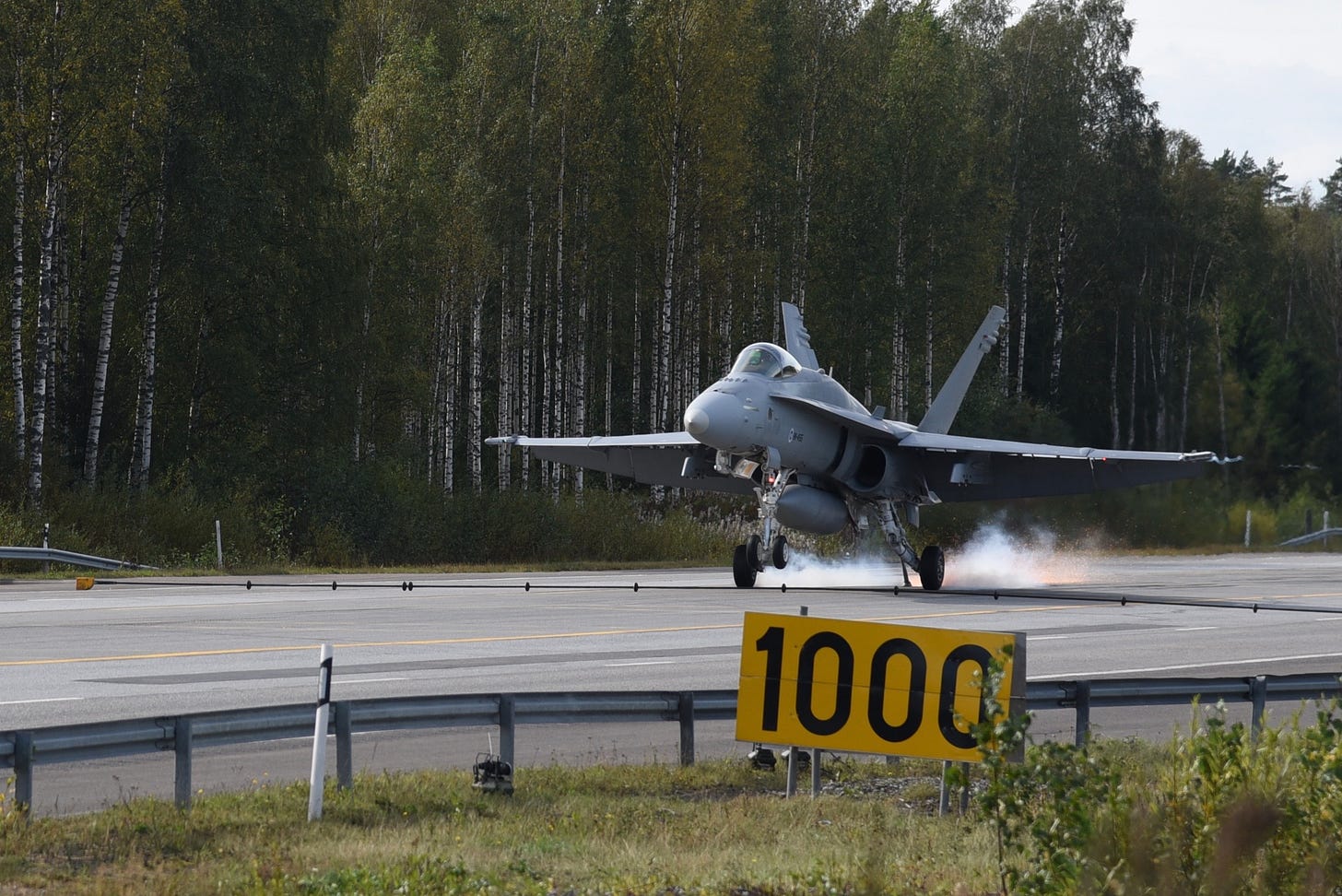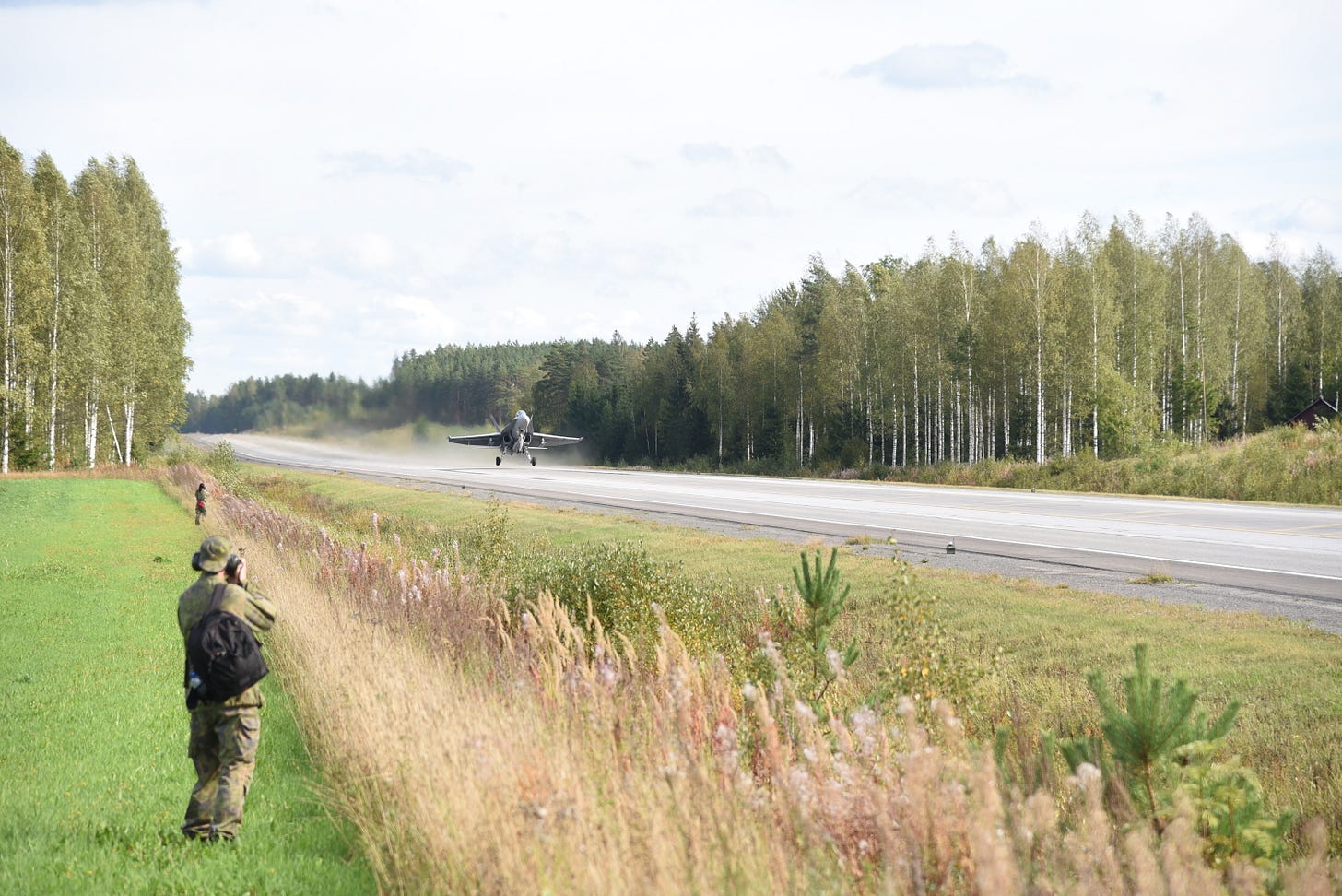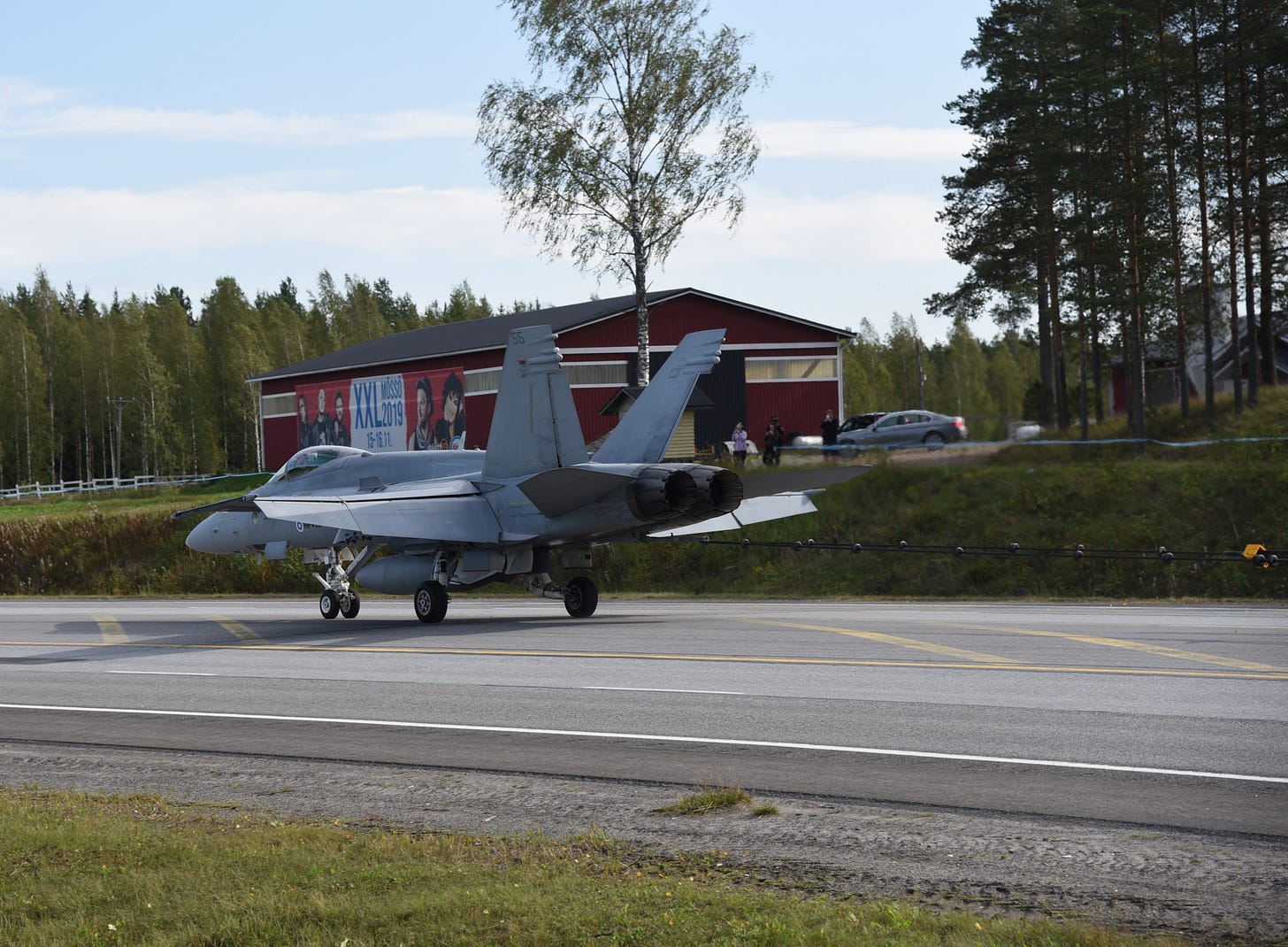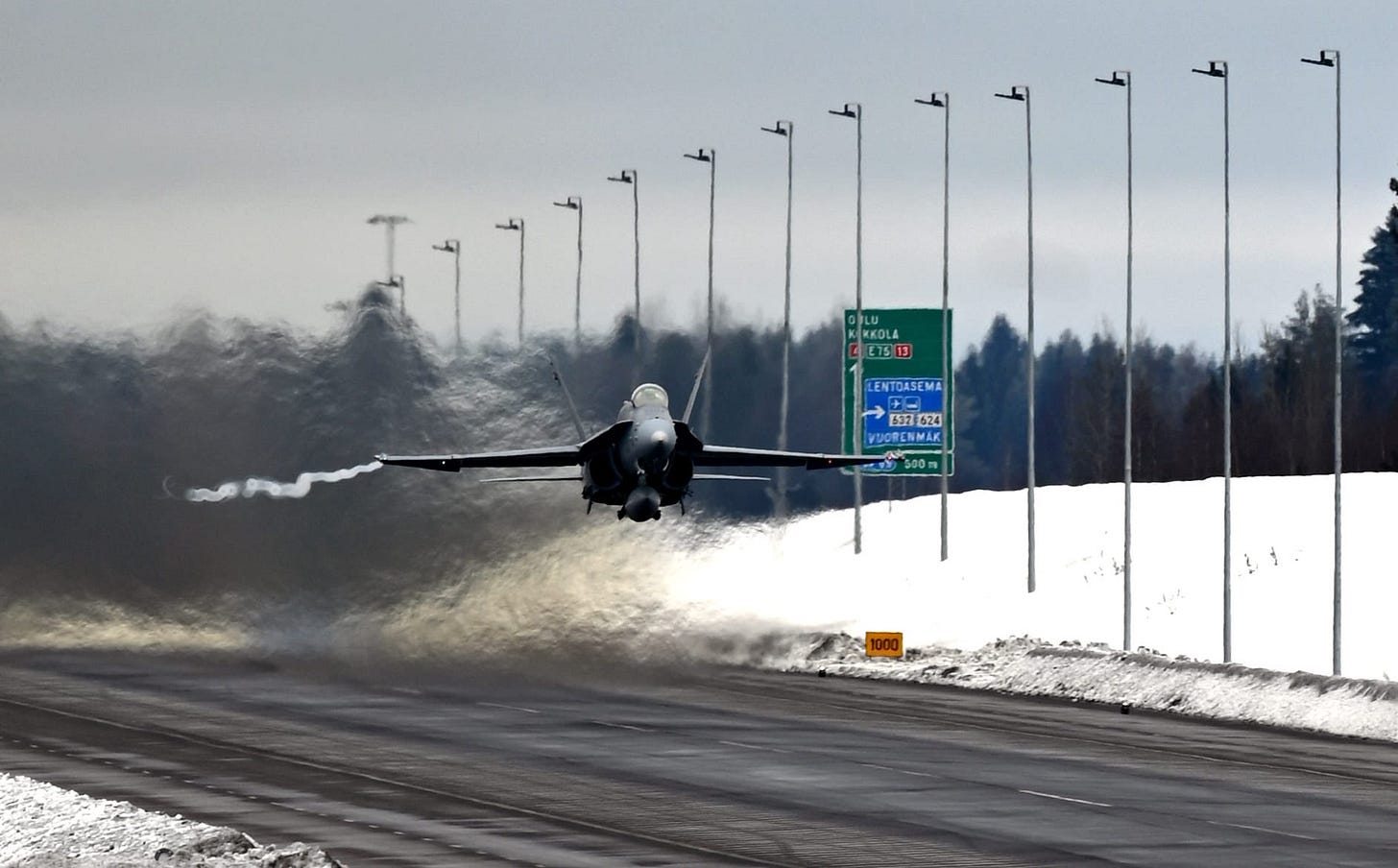Dispersal: When all of your bases are within enemy missile range.
Finnish Air Force: We're here, we're there, we're everywhere.
Many of you are undoubtedly familiar with the maps of the Pacific Ocean that feature those looming red circles- the ones that show the range of Chinese missiles of various kinds. Well, for Finland the entire country falls within missile range of its border with Russia. This isn’t new. Even under the Intermediate Nuclear Forces (INF) treaty, which banned missiles with ranges between 500 and 2500nm, Finland was covered by Russian missiles.
In an era of guided missiles and satellite imagery, the Finns expect that their airfields will be hit early in any conflict with Russia. So, what is an Air Force to do?
One option is expensive air defense systems that have a limited number of missiles and would likely be overwhelmed. Another, less expensive and more enduring option?
Dispersal. The Finnish Air Force regularly practices this, with its F/A-181s and support operations moving to small airports and designated portions of highway. Reservists are prepared to activate, operate, and defend these mobile locations, creating targeting difficulties for their adversaries. The ability to operate from roadways is so important that it is rumored that the Soviet Union required Finland to build highways that were purposefully unsuitable for aircraft as part of the Finno-Soviet Treaty of 19482. I can’t verify this, but many Finns I know seem quite willing to blame some unnecessarily winding roads on the Russians.
For the shortest or iciest strips, the F/A-18s can make arrested landings. Now it’s not quite the same as a carrier landing but is a very useful capability in Finland’s climate.
I know all of this now, but I did not back in 2018 when I visited a Finnish Air Force base. I noted that the F/A-18 on display had a tailhook, and I asked a young NCO why. His answer- for short highway landings and low-friction coefficient (i.e. winter) conditions- made perfect sense. I later saw this in action during the Finnish Air Force exercise BAANA 2019, where I took some of the pictures displayed in this post.
But in Finland, you need to exercise in the winter. On March 2nd the Finnish Air Force wrapped up Hanki 24, an exercise that involved 3,800 personnel (including 2,300 reservists) and 40 aircraft operating from eight different bases and nearby road strips.
The objective of the exercise is to develop the readiness and capabilities of the Air Force. We will train base operations and the implementation of large-force air operations from dispersed locations. One of the most important training goals is to give our reservists practice, in winter conditions, of tasks laid down in the Air Force operational concept, says Exercise Director, Brigadier General Timo Herranen, Chief of Staff, Air Force Command Finland.
The Hanki 24 exercise will provide training in versatile and realistic scenarios, and the units will practise combat in the air and at the bases. As per the Air Force agile combat employment concept, the exercise units will also use a highway strip adjacent to the airfield at both main operating bases. Highway 4 in Tikkakoski and road 9523 (Norvatie) in Rovaniemi will be closed to traffic.
The aircraft of the exercise unit conducting air defence missions will fly not only from the main bases but also from Oulu, Pudasjärvi, Vaasa and Kokkola-Pietarsaari airfields as well as Kallax Air Base in Luleå, Sweden. The fighters simulating the adversary in the exercise will operate out of Karelia Air Wing's Rissala Air Base during the entire event.
The Hanki 24 air activity will involve flight operations at low altitudes and supersonic flying at an altitude of more than 10 kilometres above the mainland. During the exercise, fighters will deploy countermeasures such as flares and chaff. Flares may be seen as momentary bright spots of light in the sky, and chaff may cause echoes on weather radar.
These dispersal operations don’t just involve the aircraft, but the entire range of support operations- refueling, rearming, maintenance, secure communication, and force protection- most of which are conducted by reservists3. For maintenance, the Finns follow a different model than my U.S. Navy colleagues are used to- basically, they do not go for specialists. Instead, they train individual maintainers to a high degree in all the maintenance disciplines. With many dispersal sites and a relatively small number of maintainers, this makes perfect sense. When I first heard the Finns use the phrase “force protection",” I pictured a security guard at an entry control point. When I saw the Finns do force protection, it was using light infantry to aggressively patrol an area with the expectation of contact. (As an aside, if you hear a Finn talk about “military police” they really mean urban combat specialists.)
Hanki 24 Motivational video here:
In 2021, after a lengthy competition, the Finnish Air Force selected the F-35 to replace their aging F/A-18 aircraft. The first delivery to Finland is scheduled for 2026, with full operational capability in 2030.
Good thing the F-35 can also land on a road base:
Due to restrictions arising from the post-WW2 peace agreement, Finland was prohibited from having an air to ground capability until 1990. The F-18s initially acquired by Finland in the early 1990s did not, as such, have a ground attack capability. This was added to the aircraft in the second mid-life upgrade, conducted between 2012 and 2016.
I’ve been unable to confirm this, and it isn’t called for directly in the text of the treaty or its supporting documents. However, many Finns have told me about the Soviets requiring winding highways during the time when the treaty was in effect (1948-1990).
Finland maintains 100% male conscription. Following the 6-, 9-, or 12-month conscript phase (which is entirely training), every conscript becomes a member of the reserve until age 50. Women can volunteer for service and do so in ever-increasing numbers.









>I noted that the F/A-18 on display had a tailhook, and I asked a young NCO why. His answer- for short highway landings and low-friction coefficient (i.e. winter) conditions- made perfect sense.
I don't think this is necessarily true. Pretty much all fighters have tailhooks (even Air Force ones) in case they need to do a high-speed abort or have brake problems. Obviously, an F-16 or the like isn't stressed for carrier landings, and the hook design is quite different to minimize weight (IIRC, there's an explosive bolt holding it back, and it requires maintenance to retract if the pilot deploys it). For naval fighters flying from land, they usually just leave the naval tailhook system in place because it's easier than designing a new one.
That said, Finland could have a portable arrestor system. I just wouldn't assume they do on the basis of the tailhook being fitted.
It was Dupuy who wrote that dispersal was the response to increased lethality on the battlefield. True then and still true now. For reference see the HERO study and QJ model along with the book "Numbers, Prediction and War."